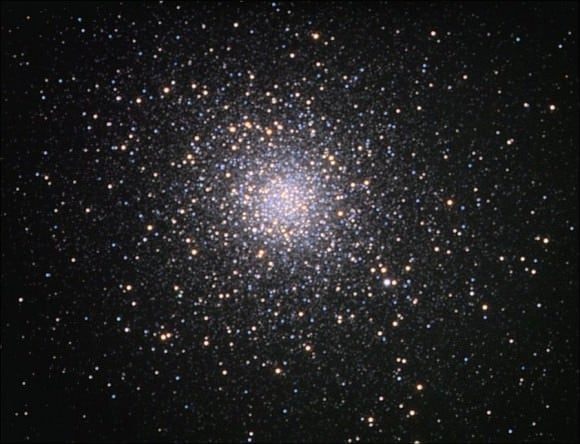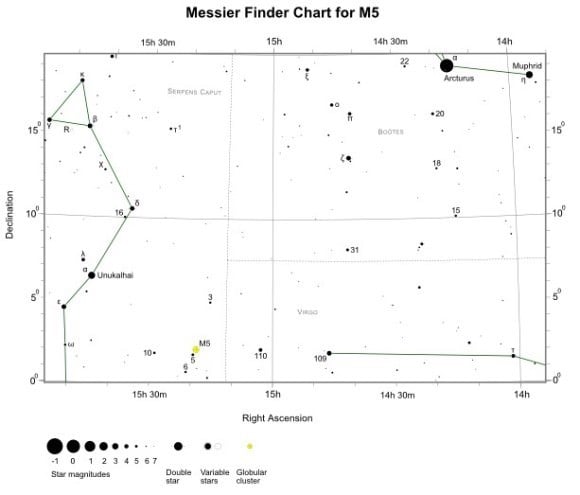In the late 18th century, Charles Messier was busy hunting for comets in the night sky, and noticed several "nebulous" objects. After initially mistaking them for the comets he was seeking, he began to compile a list of these objects so other astronomers would not make the same mistake. Known as the
Messier Catalog
, this list consists of 100 objects, consisting of distant galaxies, nebulae, and star clusters.
Among the many famous objects in this catalog is the M5 globular star cluster (aka. NGC 5904). Located in the galactic halo within the Serpens Constellation, this cluster of stars is almost as old as the Universe itself (13 billion years)! Though very distant from Earth and hard to spot, it is a favorite amongst amateur astronomers who swear by its beauty.
moreDescription:
At 13 billion years of age, M5 is believed to be one of the oldest globular clusters in our galaxy (over twice the age of our Solar System). Located 24,500 light years from Earth, it is home to more than 100,000 stars, with some estimates saying it has as many as 500,000. Of these, 105 variable stars call M5 home, as does a dwarf nova.
[caption id="attachment_127622" align="aligncenter" width="437"]
The M5 globular cluster located within the Serpens constellation. Credit: iau.org
[/caption]
The cluster is also one of the largest known, measuring 165 light-years in diameter and exerting a gravitational influence over a radius of 200 light-years. The brightest and most easily observed variable star in M5 -
Cepheid Variable 42
- changes from magnitude 10.6 to 12.1 in a period of just under 26.5 days. Amateur astronomers are encouraged to keep an eye out for it. Interestingly enough, M5 is also home to two millisecond pulsars, which were also discovered in 1997 by
S. B. Anderson et al.
over a five year period of observations.
History of Observation:
Gottfried Kirch and his wife Maria were the first to make a recorded observation of M5 on May 5th, 1702. While searching from comets, they stumbled across a huge, bright object that they considered to be a "nebulous star." On May 23rd, 1764, Charles Messier found it independently and labeled it as M5. As he recorded of it at the time:
In 1771, while compiling the first edition of the Messier Catalog, he described the object and his observations of it in more detail:
[caption id="attachment_127623" align="aligncenter" width="580"]
A wide-angle photograph of the M5 globular cluster. Credit: Robert J. Vanderbei
[/caption]
Enter William Herschel, who once again saved the day by seeing this object for what it was. In 1791, he was able to resolve the individual stars and counted up to 200 in this globular cluster. As he wrote of the cluster at the time:
Locating Messier 5:
Finding Messier Object 5 in binoculars is much like finding M3 - the key is the
Arcturus star
and the secondary star hop is Antares. You'll find M5 about 1/3 the distance between Alpha Bootes and Alpha Scorpii. For finderscopes, place Arcturus in the center and look for bright 109 and 110 Virginis to the southwest. To the east you'll see a small triangle of stars - aim there.
[caption id="attachment_127624" align="aligncenter" width="580"]
Messier finder chart for M5. Under very good viewing conditions, M5 can be just about glimpsed with the naked eye as a faint point of light. Credit: freestarcharts.com
[/caption]
Under ideal viewing conditions (i.e. where light pollution is not an issue), M5 can be spotted with the naked eye. It will appear as a faint point of light, located about 5° to the south-east (or 30 minutes to the east) of Alpha Serpentis (aka. Unukalhai). Using binoculars, spotting M5 is easy since it will appear quite bright, even under urban skies. However, it will be difficult to resolve because it is so dense.
Small telescopes will also have difficulty resolving this globular cluster, but will begin to pick out edge stars and notice that its shape is not quite round. Larger aperture telescopes will easily begin resolution and notice that nearby 5 Serpentis is also a double star.
For your convenience, here are the quick facts for Messier 5:
- Object Name
-
Messier 5
- Alternative Designations
-
NGC 5904
- Object Type
-
Class V Globular Cluster
- Constellation
-
Serpens
- Right Ascension
-
15 : 18.6 (h:m)
- Declination
-
+02 : 05 (deg:m)
- Distance
-
24.5 (kly)
- Visual Brightness
-
5.6 (mag)
- Apparent Dimension
-
23.0 (arc min
)
Enjoy your observations, and keep watching for Variable 42!
We have written many interesting articles about Messier Objects here at Universe Today. Here's Tammy Plotner's
Introduction to the Messier Objects
,
M1 – The Crab Nebula
, and David Dickison's articles on the
2013
and
2014
Messier Marathons.
Be to sure to check out our complete
Messier Catalog
.
For more information, check out the
SEDS Messier Database
.
 Universe Today
Universe Today



